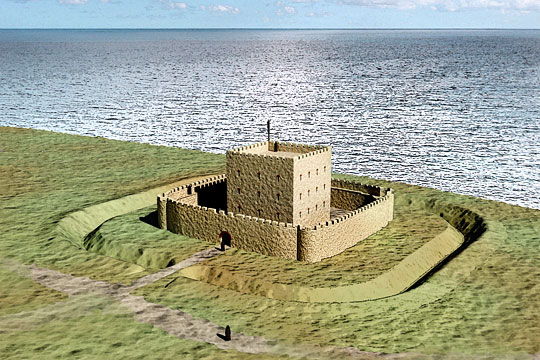Significance of Scarborough Castle
Scarborough is significant both as a medieval royal castle which played a prominent part in national events as an important gateway to north-east England, and for the architectural importance of its great tower and 13th-century defences.

Roman Signal Station
The Romans built a signal station here in the 4th century, one of a coastal chain that watched for seaborne raiders.
Royal Castle
Scarborough is of national historical importance as a medieval royal castle. It figured prominently in national events throughout the Middle Ages and Tudor period and was besieged several times. Its importance is reflected by its nomination, along with the castles of Dover, Nottingham, Bamburgh and Corfe, as a bargaining counter in the peace arrangements of 1265 between Henry III and his rebellious barons.
In 1312 it was briefly the scene of a siege when Edward II's favourite, Piers Gaveston, took refuge here. Shortly after his surrender he was summarily beheaded.
During the Pilgrimage of Grace in 1537 the castle was successfully held for the king against rebel forces.
Architectural Importance
The castle is of architectural significance particularly for Henry II's great tower and for its outstanding and well-preserved series of 13th-century fortifications, in which King John and Henry III both invested vast sums.
The great tower has the earliest externalised forebuilding in the north of England,[1] and King John's chamber block in the outer bailey is a rare survival: the only substantial parallel for this period is the 'Gloriette' at Corfe Castle, Dorset.[2]
Of significance too is the planned settlement of surprising scale by Henry II beneath the castle walls; Henry III also invested heavily in the town.
Civil War and After
Scarborough played an important role in the Civil War, and is particularly valuable for the unusually detailed account of the first siege preserved in the diary of Sir Hugh Cholmley.
From the mid-17th century Scarborough became a permanently garrisoned fortification. The buildings for the garrison are well documented and the Master Gunner's House survives in good condition, one of a group of such residences created across the country in the 18th century (such as in Walmer and Dover Castles in Kent), testifying to Scarborough's continuing military importance after the Middle Ages.
READ MORE ABOUT SCARBOROUGH CASTLE